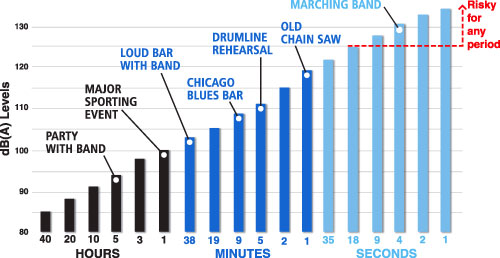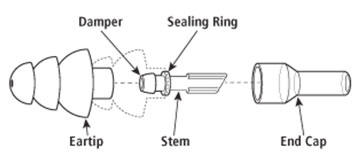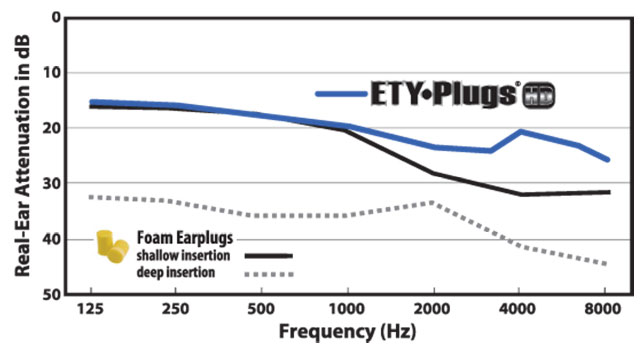Hearing loss is a function of exposure time, the average sound level, and the peak level of very loud sounds. Exposure to excessive noise from industrial machinery, heavy construction equipment and vehicles, power tools, aircraft, gunfire, motorcycle and auto race tracks, dental drills, sporting events, fireworks, rock concerts, marching bands, and music from a player’s own instrument or nearby instruments can cause hearing loss depending on the intensity and duration of the noise. Some persons are more susceptible to hearing loss from high-level sound than others.
Some workers obviously need high-attenuation earplugs. Shipbuilders, flight crew who stand behind jet aircraft on the flight deck, and army tank operators usually fall in this category. Such individuals can’t get enough attenuation for proper protection even with plugs and earmuffs combined. But, many industrial workers can be adequately protected with as little as 10 dB of attenuation: the majority of eight-hour equivalent noise exposures fall between 85 and 95 dB. Some of these workers receive earplugs that provide too much attenuation, and as a result they do not insert them deeply in their ears because they cannot hear speech clearly enough. These person’s risk hearing damage, but have compromised so they have auditory awareness of sounds around them.
The cochlea has two types of hair cells, inner and outer. The outer hair cells appear to provide the ear’s sensitivity to hear quiet sounds. Inner hair cells appear to provide all the information to the brain. It has been suggested that high-intensity noise causes extensive damage to the inner and outer hair cells; long-term lower-level noise causing the same audiometric loss may show predominately outer hair cell loss. What this implies is that the type of noise exposure may determine the severity of future communication problems.
Tinnitus (ringing in the ears) and temporary hearing loss can occur from a single concert, sporting event or sudden loud noise like a firecracker. In rare cases, permanent hearing loss results from such auditory insults. Even if a temporary hearing loss recovers over a period of hours to days, there is a risk that repeated exposure to loud noise will result in permanent hearing loss.
It is important that hearing protection is carefully selected for each individual, based on the intensity level, duration, and type of noise exposure.
Allowable Weekly Sound Exposure To Be Safe
Hearing Protection, such as ETY Plugs can make a significant difference in reduced the harmful effects of noise on your hearing.
ETY•Plugs HD use a tuned resonator and acoustic resistor to replicate the natural response of the ear canal. This unique construction, combined with Etymotic’s proprietary sound path, reduces sound levels evenly across the frequency range without changing the sound quality. Result: The sounds of tools, machinery, vehicles and speech are clear, but softer and safer.
ETY•Plugs HD provide almost equal sound reduction (20 dB) across the range of hearing. Foam
earplugs reduce the high frequencies, resulting in muffled sound.
Recommended Maximum Weekly Exposure (NIOSH, 1998)
| Sound level (dB) | Exposure type; | No protection | Using ER•20s |
| 60 | Conversation | SAFE | SAFE |
| 80-85 | Noisy restaurant Vacuum cleaner Average factory |
40 HRS. | SAFE |
| 88 | Circular saw Loud party Motorcycle |
20 HRS. | SAFE |
| 94 | Subway Riding mower |
5 HRS. | SAFE |
| 97 | Live band | 2.5 HRS. | 40+ HRS. |
| 100 | Sporting event Chain saw Snowmobile |
1.25 HRS. | 40+ HRS. |
| 112 | Blues bar/Rock concert | 5 MINS. | 8 HRS. |
| 115 | Ambulance siren | 2.5 MINS. | 4 HRS. |
| Above 125 dB you are at risk for any period without maximum protection | |||
| 140 | Jet engine Gunshot Firecracker |
INSTANT LOSS | |
Allowable Daily Exposure (OSHA and NIOSH)
| source level in dB | 85 | 88 | 90 | 92 | 94 | 95 | 97 | 100 | 105 | 110 | 115 | 120 |
| OSHA | 16 | 8 | 6 | 4 | 3 | 2 | 1 | 1/2 | 1/4 | 1/8 | ||
| NIOSH | 8 | 4 | 1 | 3/4 | 1/2 | 1/4 |
If you would like to protect your hearing, or have any questions about customer hearing protection, please call us on 01903 500636.



